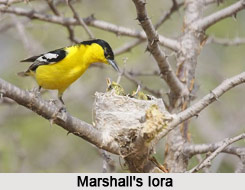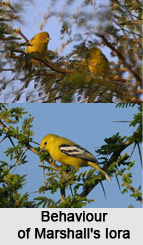 Marshall`s Iora which is also known as White-Tailed Iora is a songbird, concentrated in the Indian States and Srilanka.
Marshall`s Iora which is also known as White-Tailed Iora is a songbird, concentrated in the Indian States and Srilanka.
The White-Tailed Iora or Marshall`s Iora is an Indian bird that bears a scientific name "Aegithina nigrolutea". It is a songbird in the genus Aegithina found in parts of India and Sri Lanka. Walter Koelz collected two adult specimens of the species at Salem and the distribution range of the species is believed to overlap significantly with that of A. tiphia.
Description of Marshall`s Iora
The status of Marshall`s Iora has been debated and has only recently been given full species status. The earlier suggestions have been that it was a clinical variant of the common Iora Aegithina tiphia.
Structure of Marshall`s Iora
The diagnostic features of Marshall`s Iora are the short wing and tail; white edging to tertials converging broadly at the tip, versus tertial tips black to only narrowly white in tiphia and a smaller and shorter bill than tiphia from any part of India.
Voice of Marshall`s Iora
 The vocalizations are also different. The species is best known from north-western India, however, only a few verified specimen records exist from southern India. It is now also known from Sri Lanka. There are several races of the common iora that may appear similar to this species. Salim Ali collected a specimen in the Biligiriranga Hills, Chamarajanagar District, Karnataka which was commented upon by Hugh Whistler.
The vocalizations are also different. The species is best known from north-western India, however, only a few verified specimen records exist from southern India. It is now also known from Sri Lanka. There are several races of the common iora that may appear similar to this species. Salim Ali collected a specimen in the Biligiriranga Hills, Chamarajanagar District, Karnataka which was commented upon by Hugh Whistler.
Sexes of Marshall`s Iora
The adult females of Marshall`s Iora of both species are entirely green above (except for a grey and white tail in nigrolutea) and yellow (dull in winter, brighter in spring). The juvenal and first-winter plumages in both sexes of both species are similar to their adult female plumages. First-year birds are best recognized by the possession of more pointed and somewhat narrower tail feathers.
Courtships of Marshall`s Iora
Walter Koelz collected two adult specimens of the species at Salem and the distribution range of the species is believed to overlap significantly with that of A. tiphia. The species of Marshall`s Iora is believed to have a courtship display not unlike that of the common iora. Breeds from June to August and nests low in a bush.
Nests of Marshall`s Iora
It is presumed that Marshall`s Iora to be resident bird but little is known.



















